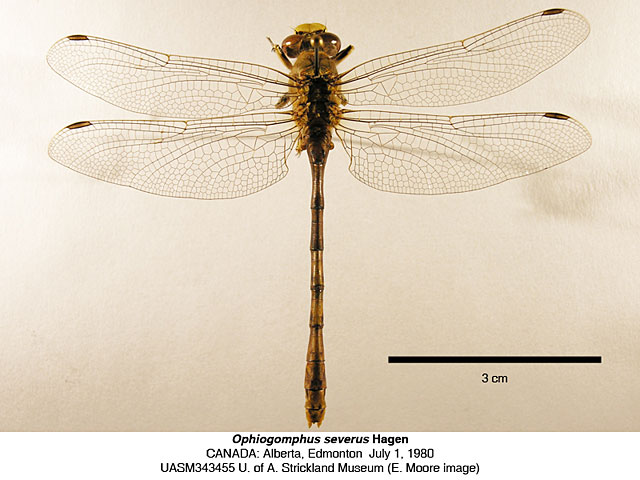Species Details
Ophiogomphus severus
Freshwater Invertebrate Collection Read more about this collection »
Common NamePale Snaketail
SeasonalityAdults have a flight season occurring from May to September.
IdentificationColoration of Ophiogomphus severus is similar to its close relatives, except that O. severus has a larger proportion of black across the entire body. The head and eyes are yellow with a black line across the frons and a black vertex. Eyes do not meet dorsally. Thorax is more greenish yellow than the head and abdomen with a diagnostic dark brown oval on the prothorax. Both the forewings and the hindwings have a yellow costal vein, but dark venation color throughout the rest of the wing. Leg segments show a mottled color pattern, the leg base yellow, the tarsi black and the femur and tibia displaying both colours. Abdomen is primarily yellow and black. Lateral stripes are continuous from the first to the terminal abdominal segment while the dorsal stripe is arranged as a row of large yellow spots ending on the ninth segment. Caudal appendages are also entirely yellow. Males and females of this species look very similar, but can be differentiated by more color on the legs of the female (Needham, et al 2000).
This species is divided into two subspecies: Ophiogomphus severus severus Hagen (described above) and Ophiogomphus severus montanus Selys which is described as having a larger lateral brown spot on the prothoracic segment and more black on segment 10 of the abdomen (Needham, et. al. 2000).
Scientific Name
Ophiogomphus severus
Common Name
Pale Snaketail
Seasonality
Adults have a flight season occurring from May to September.
Identification
Coloration of Ophiogomphus severus is similar to its close relatives, except that O. severus has a larger proportion of black across the entire body. The head and eyes are yellow with a black line across the frons and…
Coloration of Ophiogomphus severus is similar to its close relatives, except that O. severus has a larger proportion of black across the entire body. The head and eyes are yellow with a black line across the frons and a black vertex. Eyes do not meet dorsally. Thorax is more greenish yellow than the head and abdomen with a diagnostic dark brown oval on the prothorax. Both the forewings and the hindwings have a yellow costal vein, but dark venation color throughout the rest of the wing. Leg segments show a mottled color pattern, the leg base yellow, the tarsi black and the femur and tibia displaying both colours. Abdomen is primarily yellow and black. Lateral stripes are continuous from the first to the terminal abdominal segment while the dorsal stripe is arranged as a row of large yellow spots ending on the ninth segment. Caudal appendages are also entirely yellow. Males and females of this species look very similar, but can be differentiated by more color on the legs of the female (Needham, et al 2000).
Life History
This species is divided into two subspecies: Ophiogomphus severus severus Hagen (described above) and Ophiogomphus severus montanus Selys which is described as having a larger lateral brown spot on the prothoracic segment and more black on segment 10 of the abdomen (Needham, et. al. 2000).
In 2004, K. Gibbs et al studied six species of Ophiogomphus that were found coexisting in Maine. Ophiogomphus severus was not included in this study, but it can be assumed that it has a similar life history to its…
In 2004, K. Gibbs et al studied six species of Ophiogomphus that were found coexisting in Maine. Ophiogomphus severus was not included in this study, but it can be assumed that it has a similar life history to its closely relatives because of their synchronous emergence patterns. Sexually mature adults are completely terrestrial and are capable of flying great distances over land in search for food, but most of the adult life is spent near water where mate selection, reproduction and oviposition take place. Mating usually occurs during June, July and August. Females oviposit their eggs close to a shallow freshwater source. Aquatic nymphs emerge shortly after and enter a series of 9 to 15 molts before reaching the final instar larval phase. Instars then overwinter in diapause, emerging from the water and undergoing complete metamorphosis two years later as a winged adult.
Conservation
Not currently a concern. Populations of O. severus are widespread in their range and are not presently declining.
Diet Info
Adults typically feed on other flying insects found near aquatic environments such as mosquitoes, but diet also includes flies, ants and small other small flying insects.
Range
Found commonly in western Canada and United States, but specimens have been collected as far east as Ontario. Not typically found north of the British Columbia and Yukon border.
References
Title
Ophiogomphus severus; Pale Snaketail.
Author
Needham, J. G., Westfall, M. J., May, M. L.
Title
Dragonflies of North America (Rev. Ed.).
Publication Date
2000
Pages
939
Title
Odonata: Ophiogomphus severus.
Author
Gibbs, K. E., Bradeen, B., Boland, D.
Title
Spatial and Temporal Segregation Among Six Species of Coexisting Ophiogomphus (Odonata: Gomphidae) in the Aroostook River, Maine.
Publication Date
2004
Series Title
Northeastern Naturalist
Volume
11
Pages
295-312
DOI
10.1656/1092-6194(2004)011[0295:SATSAS]2.0.CO;2
Specimen Information
There are 3 specimens of this Species.
IN1492 - Ophiogomphus severus
Freshwater Invertebrate Collection
Place CollectedCanada: Alberta, Milk River (Undet.)
Collected ByBraimont, S.
Date Collected1980-08-02
IN1493 - Ophiogomphus severus
Freshwater Invertebrate Collection
Place CollectedCanada: Alberta, Milk River (Undet.)
Collected ByBraimont, S.
Date Collected1980-08-02
IN1494 - Ophiogomphus severus
Freshwater Invertebrate Collection
Place CollectedCanada: Alberta, Milk River (Undet.)
Collected ByBraimont, S.
Date Collected1980-08-02
